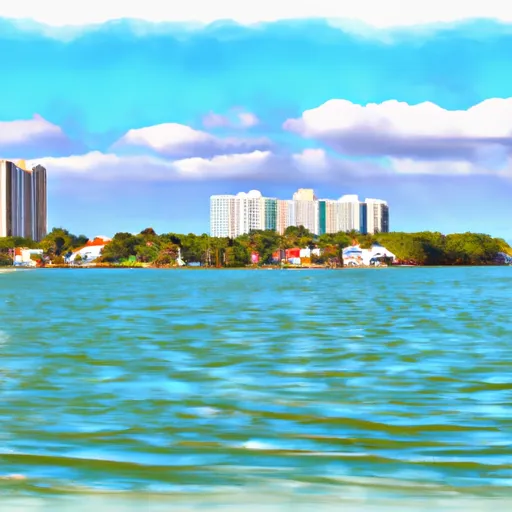-
 Snoflo Premium
Snoflo Premium
Get unlimited access to all our content
With no Ad interruptions! - Start Your Free Trial Login with existing account
Sanibel
Eden Index
Climate
6.3
•
Recreation
4.2
•
Community
1.1
•
Safeguard
4.3/10

Sanibel, Florida is a picturesque island located along the Gulf of Mexico. Known for its tropical climate, Sanibel experiences hot and humid summers, with temperatures often reaching the 90s°F (30s°C). Winters are mild and dry, with temperatures averaging in the pleasant 70s°F (20s°C). The island is also prone to thunderstorms, especially during the summer months.
Hydrologically, Sanibel is famous for its pristine beaches and crystal-clear waters. The island is home to various hydrological constituents, including numerous canals, mangrove forests, and freshwater wetlands. These diverse habitats support abundant marine and coastal life, making Sanibel a favorite spot for anglers, birdwatchers, and nature enthusiasts.
Outdoor recreation opportunities on Sanibel are plentiful. The island offers miles of pristine beaches perfect for sunbathing, swimming, and shelling. Visitors can also explore the island's extensive network of bike paths, which wind through lush vegetation and provide an excellent way to discover the island's natural beauty. Additionally, kayaking and paddleboarding in the island's serene waterways, or embarking on a chartered fishing trip, are popular activities for those seeking adventure. With its unique climate, stunning hydrology, and abundant outdoor opportunities, Sanibel, Florida is a sought-after destination for nature lovers and vacationers alike.
What is the Eden Index?
The Snoflo Eden Index serves as a comprehensive rating system for regions, evaluating their desirability through a holistic assessment of climate health, outdoor recreation opportunities, and natural disaster risk, acknowledging the profound impact of these factors on livability and well-being.
Climate Health Indicator (CHI): 6.3
Sanibel receives approximately
1370mm of rain per year,
with humidity levels near 88%
and air temperatures averaging around
24°C.
Sanibel has a plant hardyness factor of
10, meaning
plants and agriculture in this region tend to thrive here all year round.
By considering the ideal temperature range, reliable water supplies, clean air, and stable seasonal rain or snowpacks, the Climate Health Indicator (CHI) underscores the significance of a healthy climate as the foundation for quality living.
A healthy climate is paramount for ensuring a high quality of life and livability in a region, fostering both physical well-being and environmental harmony. This can be characterized by ideal temperatures, reliable access to water supplies, clean air, and consistent seasonal rain or snowpacks.
Weather Forecast
Streamflow Conditions
Peace
Area Rivers
Peace
Snowpack Depths
Peace
Reservoir Storage Capacity
Peace
Groundwater Levels
Recreational Opportunity Index (ROI): 4.2
The Recreational Opportunity Index (ROI) recognizes the value of outdoor recreational options, such as parks, hiking trails, camping sites, and fishing spots, while acknowledging that climate plays a pivotal role in ensuring the comfort and consistency of these experiences.
Access to outdoor recreational opportunities, encompassing activities such as parks, hiking, camping, and fishing, is crucial for overall well-being, and the climate plays a pivotal role in enabling and enhancing these experiences, ensuring that individuals can engage in nature-based activities comfortably and consistently.
Camping Areas
| Campground | Campsites | Reservations | Toilets | Showers | Elevation |
|---|---|---|---|---|---|
| Alafia River State Park | None | 117 ft | |||
| Lithia Springs | None | 51 ft | |||
| Edward Medard | None | 79 ft |
Catastrophe Safeguard Index (CSI):
The Catastrophe Safeguard Index (CSI) recognizes that natural disaster risk, encompassing floods, fires, hurricanes, and tornadoes, can drastically affect safety and the overall appeal of an area.
The level of natural disaster risk in a region significantly affects safety and the overall livability, with climate change amplifying these risks by potentially increasing the frequency and intensity of events like floods, fires, hurricanes, and tornadoes, thereby posing substantial challenges to community resilience and well-being.
Community Resilience Indicator (CRI): 1.1
The Community Resilience Indicator (CRI) recognizes that education, healthcare, and socioeconomics are crucial to the well-being of a region. The CRI acknowledges the profound impact of these elements on residents' overall quality of life. By evaluating educational resources, healthcare accessibility, and economic inclusivity, the index captures the essential aspects that contribute to a thriving community, fostering resident satisfaction, equity, and social cohesion.

